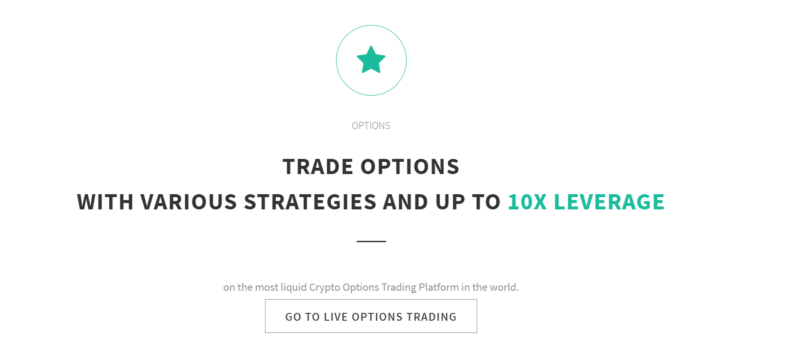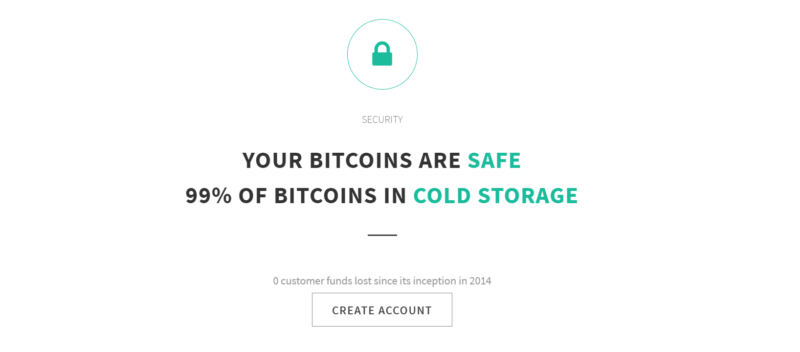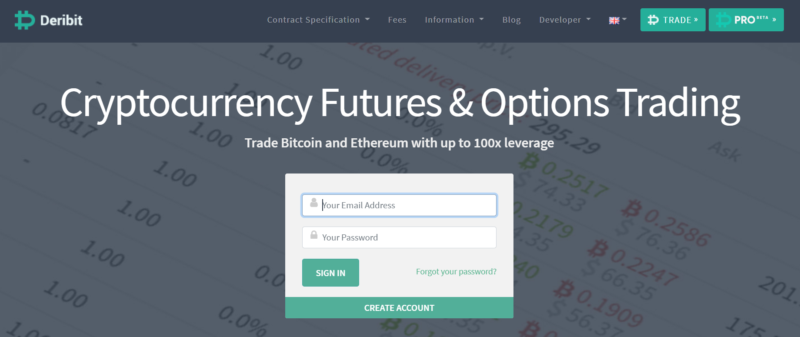
I recently wrote an in-depth guide on Bitcoin futures – where I explained that they meet the needs of a certain type of investor that wishes to place sophisticated trades. You do, of course, also have Bitcoin options – which is beginning to pick up ground in the cryptocurrency scene.
Make no mistake about it – options are even more financially complex than futures. But, once you get your head around how they work, they can be a great way to place low-risk, high-reward trades. Put simply, this is because with options – the most you can lose is the ‘premium’ that you pay to access the market.
In this guide, I am going to explain everything there is to know about Bitcoin options. I’ll discuss the specifics of how this trading scene works. Including, how they allow you to make money, the risks involved, and how you can start trading Bitcoin options today.
If you’re looking for a quick link to the best Bitcoin Options and Futures trading platforms, here are the ones I recommend:
- Deribit – my Deribit review
- Bitfinex – my Bitfinex review
- Binance – my Binance review
What are Bitcoin Options?
Options are financial derivatives. This means that the options market is dictated by the underlying asset – which, in this case, is Bitcoin.
The overarching concept of options is as follows:
- By holding an options contract, you have the ‘right’, but not the ‘obligation’, to buy or sell the respective asset.
- This is different from futures, as you do have the obligation to buy or sell the asset if you are still holding the contracts when they expire.
So, the main attraction of options is that you can speculate on the future price of an asset without needing to buy or sell it at the time of the trade. Instead, you will pay something called a ‘premium’ – which is like a non-refundable security deposit. Don’t worry, I am going to explain all of these niche terms in more detail later on.
Before you pay the premium – which is usually 5-10% of the contract value, you are then hoping to predict whether the asset will finish above or below the ‘strike’ price of the options. This works in the same way as futures.

For example, let’s say the price of Bitcoin is currently $17,200 and the strike price is $18,000. If you buy 1 options contract and Bitcoin expires at $19,000 – you made $1,000. If you held 10 contracts, then your profit would have stood at $10,000.
I should also note that much like futures, options will always have an expiry date. This is usually three months but you can also buy options on a weekly, monthly, and bi-annual basis. In most cases, you can offload your options contracts before they expire – based on the value assigned by market forces.
Before I get to the fundamentals, let’s look at a really basic example of what a Bitcoin options trade might look like.
- You are interested in a 3-month Bitcoin options contract
- The options have a strike price of $15,000
- The premium on each contract is $750
- You decide to buy two options contracts – so you pay a total premium of $1,500
- When the options expire, Bitcoin is worth $17,500
- This is $2,500 above the strike price of $15,000
Although you made $2,500 per contract, you need to subtract the premium of $750
- This leaves you with a net profit of $1,750 per contract
- You bought 2 contracts, so that’s an all-in profit of $3,500
As you can see from the example above, there really is a lot to take in when trading Bitcoin contracts. With this in mind, I am going to break down each and every key term that you need to be aware of before taking the financial plunge.
Bitcoin Options – Key Terms to Learn Before Getting Started
No matter which platform you decide to trade Bitcoin options at, you always come across the terms listed below.
Calls and Puts
Both ‘calls ‘and ‘puts ‘are terms unique to the options trading space. Put simply, the one that you opt for is determined by which way you think the price of Bitcoin will go.
For example, if you are familiar with CFDs, then you will know that you need to place a ‘buy order’ if you think the asset will increase in value. The equivalent of this in the options scene is call options.
If, however, you were to short-sell at a CFD platform, you would place a ‘sell order’. In the world of options, the equivalent would be a ‘put option’.

Each and every Bitcoin options marketplace that you come across will have a price on both calls and puts. Once again, much like CFD trading, the difference between these two prices is known as the ‘spread’. This ensures that the brokerage platform makes money no matter what happens.
Nevertheless, it is important to clarify that one of the many benefits of trading Bitcoin options is that you short the digital currency. But, unlike CFDs, you won’t be hit with overnight swap-fees. More on this later.
Strike Price
As I briefly mentioned earlier, both options contracts always come with a strike price. If you know how futures work, then you should already have a general idea of how this works. If not, the strike price is the price that markets ‘believe’ the underlying asset will close at when the options expire.
For example, you might have a strike price of $17,000 on 1-month Bitcoin options and $17,400 on its 3-month counterpart. It is your task to then predict whether the price of Bitcoin will finish above or below this figure. It goes without saying that the strike price is determined by market forces, as opposed to the exchange itself.
For example, if the current price of Bitcoin is $15,000 and the strike price on a 3-month contract is $16,000 – then the markets anticipate an upward trajectory. However, the strike price was, say $13,000 – then this would indicate a bearish market.
- Put simply, if you think Bitcoin will be worth more than the strike price when the contracts expire, you need to purchase call options.
- If you think Bitcoin will be worth less than the strike price when the contracts expire, you need to purchase put options.
Premium
The ‘premium ‘is not something that you need to worry about when trading futures. However, this sits at the core of options – so let me explain how it works. In order to access your chosen Bitcoin options market, you don’t need to purchase the contract in full. Instead, you only need to cover the premium – which is a small percentage of the contract value.
For example, if you are trading a stock worth $20 and the premium is $0.10 – you are effectively paying 5% upfront. The premium itself is determined by various factors – which I will cover in more detail shortly.

Now, before I go any further, it is important for me to note that the premium is not the same as margin trading. These are two completely different things. The margin is something you pay to your broker to trade with leverage. The premium, however, simply gives you to ‘option’, but not the ‘obligation’, to buy or sell the underlying asset.
Crucially, the premium is the most amount of money that you can ever lose on an options trade. This is because when it comes to settlement if your trade didn’t end up being profitable, you simply walk away. This is the beauty of Bitcoin options, as you target large gains while at the same time keeping your risks to a minimum.
Let me give you a brief example of how the premium works on a losing trade:
- You are looking at a 1-month Bitcoin calls options contract that has a strike price of $19,000
- The premium on each contract is $950
- You buy 3 contracts – meaning your total premium outlay is $2,850
- You keep hold of the contracts until they expire
- When they do, Bitcoin is worth $18,700
- This is just short of your $19,000 strike price target, meaning that the options contract expired worthless
As per the above, you obviously did not exercise your right on the options, as you finished below the strike price. As such, your total loss on this is trade is simply the premium – which amounted to $2,850 across your three call options.
Contract Value
In the example above, I explained that the premium on one Bitcoin options contract amounted to $950. This is 5% of the total value of the strike price – which was $19,000.
Now, I should make it clear that this is a lot of money to be risking on a speculative asset class like Bitcoin options. After all, if your prediction is incorrect, you will lose the premium that you paid upfront in its entirety.
As such, platforms targeting retail clients (non-professional traders) will offer a much smaller contract value.
For example:
- Let’s suppose that the value of each contract is 0.1 BTC.
- If the strike price is $19,000 and we stick with the average premium rate of 5%, then this means that you only need to pay $95 on each contract.
- This is because the contract value is $1,900 ($19,000 x 0.1 BTC), and the premium is 5% ($95 of $1,900 is 5%).
Once again, the above example highlights just how complex options contracts are – especially when it comes to quantifying the value of the premium against that of the strike price.
How is the Premium Calculated When Trading Bitcoin Options?
The underlying process of calculating the premium on an options contract is super advanced. In fact, the specific price is based on a full range of variables.
This includes:
Duration
Put simply, the longer the options contract duration, the higher the premium will be. This does make sense, as a 6-month contract would give you significantly more time to ‘land in the money’ than a 1-month contract.

By land in the money, I mean seeing Bitcoin hit a price that is above or below the strike price – and in your favor. For example, if you purchased call options at a strike price of $14,000 and Bitcoin surpasses this price before they expire, you are in the money.
Strike Price
In the vast majority of cases, your chosen Bitcoin options broker will offer various strike prices on the same market.
For example, let’s say that Bitcoin is currently priced at $17,000. On a 1-month Bitcoin options market, you might be offered the following strike prices:
- $17,500
- $18,000
- $18,500
- $19,000
- $19,500
Now, it goes without saying that the odds of Bitcoin surpassing $19,500 before the 1-month contract expires is substantially less likely than the digital currency surpassing $17,500. After all, it only has a month to reach these target strike prices.
As a result, it makes sense that the premium on $19,500 strike price call options is going to be higher than that of a $17,500 strike price.
This is also the case with put options but in reverse. For example, the premium on $17,5000 is going to be higher than that of $19,500 – as the likelihood of ending in the money increases!
Implied Volatility
Implied volatility refers to how volatile the markets think a particular asset is likely to be while the options contract is still active. In other words, how large the price swings will be during the trade. The higher the implied volatility, the more expensive the premium is likely to be.
As you likely well know, Bitcoin is one of the most volatile and speculative asset classes in the trading scene. In turn, this means that you are likely to pay a higher premium in comparison to more stable markets – like blue-chip stocks.
Bitcoin Options – European vs American
Much like in the case of futures contracts, Bitcoin options come in two key forms – European or American.
If you purchase European-style Bitcoin options, then you have no flexibility in closing the position early. Instead, you need to wait until the options expire. As you can imagine, this is a huge hindrance from a risk management perspective.
- For example, you are unable to limit your potential losses by closing a position before the contract expires worthless.
- Additionally, you are unable to lock in your profits if your European-style contracts surpass the required strike price before expiry.
- It is for this reason that I would suggest sticking with American options.
- This is because you can exit your Bitcoin options trade at any time between the point at which you place it and the date on which the contracts expire.
On the other hand, I should make it clear that the premium on American-style Bitcoin options is going to be higher than its European counterpart. Once again, this is because you have the luxury of being able to offload the contracts before they expire!
What are the Benefits of Trading Bitcoin Options?
If you’re simply looking to buy some Bitcoin because you think its price will continue to rise over the course of time – there is no need for you to engage with options. But, as I have briefly eluded to thus far, there are many benefits that the Bitcoin options scene offers to a certain type of trader.
This includes:
Potentially Large Gains With a Small Stake
The first benefit that springs to mind is that options allow you to speculate on the future value of Bitcoin with a small amount of capital. As such, this allows you to target larger profit margins without needing to risk a large amount of money.

For example, if you are able to purchase a Bitcoin options contract at a premium of 10%, you are effectively trading with 10 times the amount you are risking.
No Limit to Potential Gains
If you go long on your desired Bitcoin options trading – meaning you are purchasing calls, there is no limit to the amount of profit that you can make. For example, you might purchase the calls at a strike price of $10,000.
For each dollar amount that Bitcoin surpasses this figure, your profit increases further. So, if your 1 call option closed at $5,000, that’s a gross profit margin of $5,000. If it closed at $20,000 – that’s $10,000 gains. And so on.
On the flip side, put options profits are capped, as the furthest south Bitcoin can go is $0!
Short Bitcoin Longer-Term Without Getting Hammered in Fees
By ‘shorting ‘Bitcoin, this means that you think the value of the digital currency will go down. Doing this towards the peak of the 2017 crypto-craze could have made you a lot of money.
However, the only way that retail clients can short Bitcoin is via CFDs. As I briefly mentioned earlier, CFDs attract overnight financing fees as they are leveraged financial products. This means that you need to pay a fee for each day that you keep your position open.
In the case of cryptocurrency CFDs, this is likely to eat into your potential gains very quickly – so it makes long-term short trade highly unviable.
This is where Bitcoin put options come into play. Crucially, the likes of Deribit offer Bitcoin options market with a duration of up to 10 months. This means that all you need to do is pay the upfront premium to access this market.
In doing so, you can effectively short Bitcoin for 10 months without needing to worry about overnight financing fees. Not only does this allow you to reduce your trading fees, but it also allows you to clearly assess what your potential profits and losses are.
Great way to Hedge
Options are used by seasoned traders as a means to hedge an open position without needing to close it. For example, you might have a large amount of Bitcoin in your portfolio and are enjoying great returns. However, you might feel that the markets are due a correction.
Rather than selling your Bitcoin, you might decide to purchase put options. In doing so, you are countering your risk. Sure, you won’t make money as both outcomes will counter each other out. Instead, this is a risk management strategy to reduce your portfolio’s overall volatility.
Crucially, when attempting to achieve this goal through options, you only need to outlay a small amount of capital via the premium.
Bitcoin Options Trading – Real Examples
Although I am going to discuss the best platforms to consider later on, I wanted to dedicate a section to some real-world examples so that you can get a 360-degree view of how a Bitcoin options trade really looks.
After all, you might feel somewhat intimidated when you first see the sheer amount of data that Bitcoin options trading platforms display.

So, in the screenshot above you will see a list of dates in the left-hand panel. This starts on November 25th (24 hours from today) right up to 24th September 2021 (10 months from today).
In my first example, I am clicking on the latter. In simple terms, this means that I need to predict where the price of Bitcoin will be on 24th September 2021. As you can see from the screenshot below, I am given a range of strike prices to choose from.
This includes:
- $8,000
- $16,000
- $18,000
- $20,000
- $24,000
- $32,000
- $40,000
As I discussed earlier, the premium that you need to pay is heavily dependant on the strike price that you opt for. Think of it like this. What is more likely – Bitcoin being worth more than $8,000 in 10 months’ time, or being worth more than $40,000 in 10 months’ time?
It goes without saying that the former is significantly more likely – meaning that you will need to pay a much higher premium to access the market.
If you did purchase calls on the $8,000 strike price, this means that your premium will amount to 0.5895 BTC.
This might not mean a lot to you, so let me give an example of two potential outcomes of this trade:
- To clarify, you are purchasing call options at a strike price of $8,000 at a premium of 0.5895 BTC
- The contracts have an expiry date of 24th September 2021
- To keep things simple, let’s say that you let the options run their course until the above date
- When they do expire, Bitcoin is worth $20,000
- So, that’s a $12,000 profit on one call option contract. But, we need to subtract the premium – which was priced in Bitcoin at 0.5895 BTC
- In theory, this means that the premium amounts to 58.95% of your profit – leaving you 41.05%
- Of $12,000 – that’s an all-in profit of $4,926
As you can see from the above, I had to quantify my profit in percentage terms. The reason for this is that while the premium was quoted in BTC, my profit was based on the amount of growth in dollar terms.
- Now let’s imagine that my Bitcoin options closed when the digital currency was $7,500
- This is just below my strike price of $8,000 – meaning that the options expired worthless
- In turn, I lost a total of 0.5895 BTC – which is the premium that I initially paid to access the market.
Now, you would think that the above example illustrates a safe bet, so to speak. After all, at the time of writing this guide Bitcoin is worth over $18,000. This is why the premium was so high. However, there are no guarantees with Bitcoin as it can move up and down in a parabolic manner.

Now let’s look at a real-world example of an options trade with a more profitable upside. This time, we’ll stick with the same expiry date of September 2021 – but at a strike price of $32,000.
- As you can see from the screenshot above, I am being quoted a premium of 0.1540 BTC
- This is significantly less than the 0.5895 BTC premium I was quoted on the above strike price example of $8,000.
- This makes sense, as the odds of Bitcoin surpassing $32,000 in the next 10 months are much higher.
- Nevertheless, let’s say that you purchase 1 call option as you think Bitcoin will be worth more than $32,000 before September 2021
- When the options expire, Bitcoin is worth $40,000
- That’s a profit of $8,000 on your 1 contract – less the premium
- In percentage terms, the premium amounts to 15.40% – so that wipes off $1,232 from our profit
- All in all, we made $6,768
If, however, Bitcoin did not surpass the $32,000-mark, you would have lost your premium of 0.1540 BTC.
All of the examples I have given in this Bitcoin options guide thus far have focused on call options. With that in mind, I am now going to give you a real-world example of a put options trade that is available right now.

As per the screenshot above, this particular Bitcoin put options market has the following specifications.
- The put options have an expiry date of 29th January 2021
- The strike price is $28,000
- The premium is 0.4620 BTC
- To keep things simple, I’ll use the current BTC/USD exchange rate given by the platform – meaning that the premium amounts to $9,037
You are purchasing 1 put option, meaning that you think Bitcoin will be worth less than $28,000 when the contracts expire at the end of January 2021.
- Let’s suppose that when the contracts expire, Bitcoin is priced at $11,000
- As such, this is $17,000 less than the strike price of $28,000
- But, we also need to subtract the premium of $9,037
- This would leave you with a profit of $7,963
Best Bitcoin Options Platforms
If you’ve read my guide up to this point, then you should now have a firm understanding of how Bitcoin options actually work. I also hope that you have a good grasp of both the potential rewards and risks. If you’re ready to take the plunge by trading Bitcoin options today, below I list some of the best platforms to do this with.
Before I get to that, these are some of the metrics that I looked for in my search for the best Bitcoin options platform:
- Variety of options markets – for example, strike prices and expiry dates
- Contract value – i.e. the minimum amount you need to stake to purchase your options contract
- Minimum deposit and supported payment methods
- Reputation in the cryptocurrency trading scene
- Fees, commissions, and competitiveness of premium
Taking the above into account – here are my top picks:
Deribit – Best All-Round Bitcoin Options Trading Platform
The real-world screenshot examples I gave above were taken from Deribit. This platform is focused exclusively on cryptocurrency derivatives and offers both Bitcoin futures and options. I like Deribit for several reasons.
In terms of its Bitcoin options markets, the platform offers heaps of contract durations. This runs from daily, weekly, monthly, quarterly, and right up to 10-months. As such, Deribit is great if you want to purchase longer-term options.
Additionally, each of the aforementioned contract durations comes with heaps of strike prices. In the example I gave earlier on 10-month contracts, this varied from $8,000 to $40,000 – which gives you plenty of flexibility to deploy an options trade that meets your requirements.
In terms of minimums, you can purchase from just 0.1 BTC of an options contract. As such, if the premium on your chosen market has a USD-value of $4,000 – you would need to outlay $400. You can, however, also apply leverage to your options trade – meaning that your financial outlay can be reduced by a considerable amount.

There is plenty of liquidity at Deribit, too – so you should never have any issues entering and exiting the market. However, I should make it clear that Deribit also comes with its flaws. At the forefront of this is that the platform only hosts European-style options.
As I mentioned earlier, this means that you need to wait for the contracts to expire before you can realize your profit or loss. In other words, you can’t offload your calls or puts before they expire. Additionally, Deribit does not accept fiat currency deposits. Instead, you need to fund your account with Bitcoin.

If you don’t have any Bitcoin to hand, you will first need to buy some and then transfer it over to your Deribit account. In terms of fees, you will initially pay a commission of 0.03% of the underlying contract value. When the contracts expire, you then pay a settlement fee of 0.015%.
Finally, Deribit is not regulated. After all, it allows you to trade cryptocurrency derivatives with leverage. The platform does, however, note that it keeps 99% of its Bitcoin holdings in cold storage. The balance is kept in hot wallets to facilitate withdrawal requests.
Binance – American-Style Bitcoin Options, But Maximum Duration of 1 Day
Binance is one of the largest cryptocurrency exchanges in terms of daily trading volume – with hundreds of pairs on offer. It has a great reputation in this space and is continuously making strides to acquire a regulatory standing.

As of April 2020 – the popular exchange entered the Bitcoin options scene. In terms of the positives, all of the options markets at Binance are American-style. This allows you to exit your position before they expire – which is ideal for risk-management purposes.
It is also notable that all commissions are built into the premium. That is to say, once you pay the premium to access your desired options market, you don’t need to worry about settlement fees. However, the main drawback with choosing Binance for your Bitcoin options needs is that it is only suitable for day traders.

This is because the maximum duration on offer is 24 hours. As such, if you’re looking to speculate over several weeks or months – Binance won’t be suitable.
Bitcoin Options Guide – The Bottom Line
In summary, Bitcoin options can be a great tool for speculating on the future value of Bitcoin. Whether that’s on a weekly, monthly, quarterly, or annual basis – these options contracts only require a premium upfront.
As such, you can potentially make large gains by risking a small amount. In turn, if your speculation is incorrect, the most you can lose is the premium itself.
On the flip side, Bitcoin options are hugely complex and there is a lot to understand before you take the plunge. This includes understanding the basics of calls and puts, strike prices, premiums, and the difference between European/American-style contracts.


Jean do you allow copy trading with your friends or members for a fee. I’m a newbie and interested in learning more this way. Or advise me on the best to follow also an opinion on trading bots, best worse. I would appreciate your input thanks.
Not really something I’d consider, I would say it’s much better for someone to learn trading deeply if it’s something they consider as a serious income stream. And if not, better not enter at all.
What is the maximum length of time you can purchase a Bitcoin call option for ?
Is it possible to purchase a call option that is longer than 10 months somewhere?
I really don’t follow how you use the Premium as a percentage. The premium is a fixed cost at the start of the contract, not a percentage applied at the end. By treating it as a percentage, it means that (for a Call option), the higher the price at expiry, the higher premium you pay in $, which doesn’t make any sense.
In your first example, you can see from your screenshot that a Bid of .5895 BTC is worth $11,605.28, and so your premium cost is $11,605.28
That means, at expiry for Strike of $12,000 when BTC is $20,000, your profit is:
20,000 – 12,000 – 11605.28 = 394.72
And not 4,926
To answer my own comment, the premium is being removed from the initial investment – rather than being an additional amount paid for the option.
So if the option contract size is 1 BTC and the premium is .5895 BTC, then you end up effectively owning an option on .4105 BTC, and so the payoff, which is based on 1 BTC, is then scaled to the amount of BTC the option actually covers
Would you please clarify this part of your article:
“For example, you might purchase the calls at a strike price of $10,000.
For each dollar amount that Bitcoin surpasses this figure, your profit increases further. So, if your 1 call option closed at $5,000, that’s a gross profit margin of $5,000. If it closed at $20,000 – that’s $10,000 gains.”
What does “it” refer to in “if it closed at $20,000?”
Question, are purchased option contracts stored in cold wallets like any other crypto asset?
Hi Ryan, contracts exist on the exchange itself.